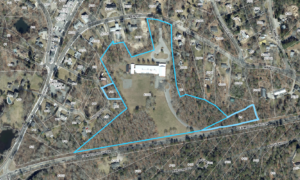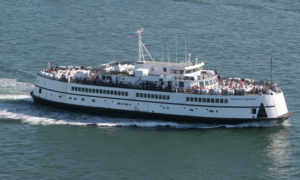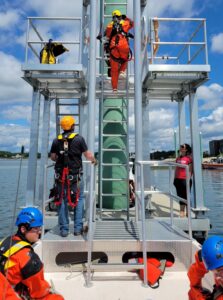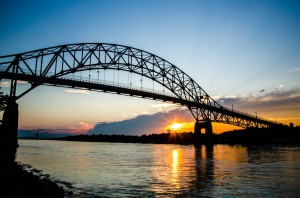
The Bourne Bridge, along with its twin, the Sagamore Bridge, are 80 years old this month.
BOURNE – For many, the Bourne and Sagamore bridges are symbols of Cape Cod, and this month marks the 80th birthday of the two iconic spans.
The bridges, both 396-feet-long and with vertical clearances of 135 feet at mean high water, were constructed as part of the New Deal’s Works Progress Administration under a program entitled the National Industrial Recovery Act of 1933.
US Army Corps of Engineers Park Ranger Samantha Gray said there were two purposes behind the bridges’ construction.
“These bridges were not only about the improvements needed at the canal at the time but also about putting people back to work at a critical time in our history,” Gray said.
The bridges replaced drawbridges that were in place from 1914 to 1935.
“Those bridges were causing issues for mariners going through [the canal]. They had a narrow opening. You had conflicts between vessels and vehicles, because only one could go at a time, so this was one of the improvements the Corps of Engineers took on in the 1930s,” she said.
The centennial anniversary of the Cape Cod Canal’s completion was celebrated last year with much pomp, but there are no public celebrations planned to mark the 80th birthday of the bridges.
The canal was a business venture by financier August Belmont, who took the idea of building a canal that had been considered for more than 100 years and made it a reality.
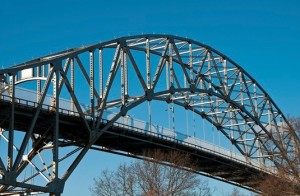
The Sagamore Bridge has a vertical clearance of 135 feet at mean high water.
The canal took five years to construct and its completion was celebrated in 1914.
But the canal was originally only 100 feet wide and could only accommodate vessels with a draft of 15 feet.
The waterway also had a toll and the drawbridges stopped traffic when large vessels passed.
Gray said the canal was not a success originally.
“They never realized the volume of traffic they and their investors had hoped for. The strong currents led to a few accidents in the canal and it got a bad rap,” she said.
In addition, the strong currents in the canal meant it needed regular maintenance dredging.
“All these factors led to the original canal failing financially,” she said.
The US government purchased the canal in March of 1928 and the Army Corps took over responsibility to improve and operate the waterway. Among those improvements was making the canal wider and deeper for maritime navigation, Gray said.
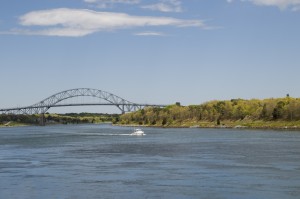
The Bourne Bridge over the Cape Cod Canal.
Adding the bridges made the canal one of the nation’s most efficient navigational waterways, according to the Corps’ history of the area.
For decades, the Cape Cod Canal was the widest sea level canal in the world but that distinction is now held by the Suez Canal.
Gray said being a sea level canal means the Cape Cod Canal does not have locks to manipulate the tides and current.
According to Gray, engineers made that decision to build a sea level canal and not to construct locks for several reasons.
First, it was less costly not to have locks to manipulate the tides and the currents, and “not to have to worry about operating and maintaining them.”
On the present canal, Gray said, “tides go up and down, and the currents go east to west in accordance to what the tides are doing out in Cape Cod Bay and in Buzzards Bay.”
Another issue, Gray said, has to do with the New England winters. “When you have really cold winters like we did this past winter with locks making the current still, you have a greater chance of freezing and then the canal not being available for vessel traffic all year.
With the strong currents we have now, you can have vessels go through throughout the year.”
In addition, the strong currents traveling through the canal mean the Corps does not need to do as much maintenance dredging.
“We don’t have a lot of sand deposits, so we don’t have to do maintenance dredging on an ongoing basis. We just have to dredge at a few spots,” she said.
Looking to the future, Gray said the Corps is now working on a multi-year major rehabilitation evaluation study, looking at the capacity of the bridges, as well as an environmental assessment.
The study is taking place at the same time as the Massachusetts Department of Transportation is working on its own transportation study of the canal area.
Residents and visitors to the Cape are often made aware of repair work on the bridges, much of it made necessary by their age.
Timothy Dugan, spokesman for the Army Corps of Engineers, said, “As they get older, they require more maintenance to keep them in good condition. That’s just routine and given the weather up here in New England, it’s pretty hard on the metal. [There is] the snow, the ice, the rain, the salt, so we have to continually monitor the shape of the bridges and repair them as needed.”
Over the past couple of years, the Sagamore Bridge has had frequent lane closures, including almost daily lane restrictions that began last fall.
Dugan said, “Every couple of years, we have to do a larger maintenance project like you’ve seen in the last couple of years where we’ve had several in a row.”
Dugan said, the Corps’ current bridge study, “will be an ongoing effort to gauge the condition of the bridges and what we need to do in the future.”
For More Information
Take a look at the below three links for even more information on the Cape Cod Canal.






